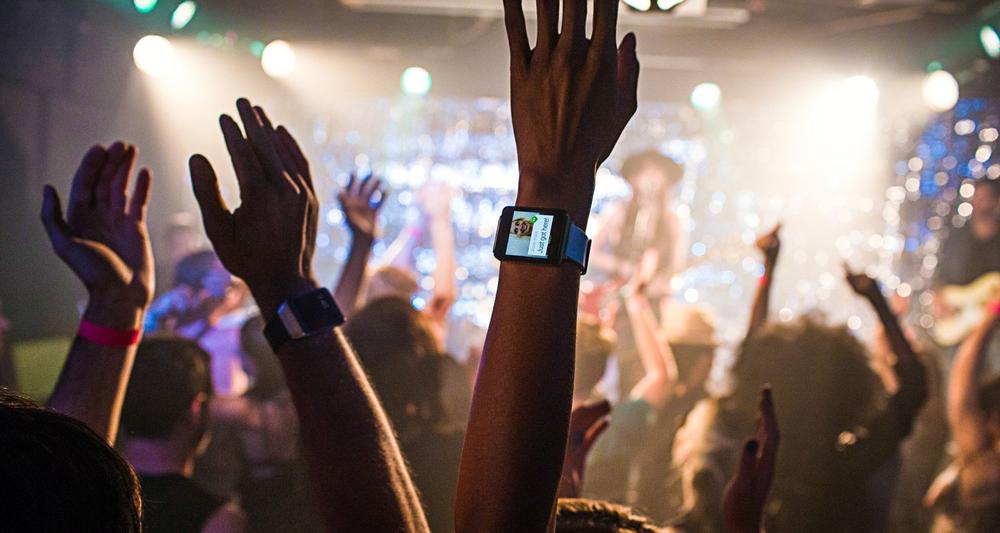Wearables will reinvent theme parks, concerts, event venues

Wearable technologies promise to transform the way people connect, share, and order pizza. But their impact will be larger than even these lofty predictions, as wearables offer brands unprecedented access to their customers’ attention and imaginations. Every year, tens of millions of tourists and thrillseekers visit theme parks around the world, exploring the one-of-a-kind sights, sounds, and heights. Thousands more music lovers flock to massive music and arts festivals like Chicago’s own Lollapalooza, which attracted more than 160,000 attendees to Grant Park this month. Now, with emerging wearable technologies and smartphone apps that enable them, big event venues and theme parks can engage with their attendees in more relevant, timely, and informative ways.
Since the market for wrist-mounted wearables is just beginning to realize its potential, certain venues are releasing low-cost gadgets of their own. As part of its MyMagic+ ticket option, Disney Parks sends attendees an RFID-enabled wristband called the MagicBand. Guests who opt into this plan receive a color-customizable wrist bracelet that serves as their entrance ticket and tracks their location throughout the park. For families, these wristbands help track children’s location and make group meetups in the often-crowded parks more manageable. But for Disney and other park operators, the kinds of data afforded by these location-aware devices provides unprecedented analytical insights for popular attractions and high-traffic areas.
But Disney’s ideas are just the beginning. Beyond simple rubber wristbands, the advent of truly smart wearables from the likes of Google’s Android Wear offers venue and park operators new capabilities for conveying information and increasing attendee engagement. Rather than handing out paper-and-ink park maps or relying on sporadic directory kiosks, brands can empower their users with location-based and situationally-aware mobile and wearable tools. An interactive park map that automatically updates based on ride closures or time-sensitive park events would allow guests to learn about the park on their own terms and have a new level of control over their experience. Fastest route to the park’s biggest, baddest ride? Just get the directions on your wrist. Hungry? Your smartwatch knows the best-reviewed watering holes. Rather than spending their precious moments reviewing a cluttered and unintuitive paper map, attendees can have their smart wearable devices deliver relevant and timely information at a moment’s notice.
Rather than spending precious moments searching through paper maps, attendees can have wearables deliver relevant information at a glance.

These advantages aren’t just true for theme parks, however. Large concert venues and festivals can benefit from better informing and empowering their attendees with wearables. For years, Lollapalooza has distributed RFID wristbands to thousands of attendees to serve as their ticket, allowing for seamless park entry with a quick, wrist-scanning turnstyle. This year, one of the world’s largest music festivals introduced an added feature on top of their wristbands called Lolla Cashless. Using the same RFID chip, users could register their wristband online in advance of the festival and connect it to their credit or debit card, allowing them to purchase food and merchandise with a wave of their wrist. Wearable payments are in their infancy, but as NFC and other sensors make their way into more and more accessible devices, this approach could allow future festival or theme park attendees to leave their wallets at home altogether.
At future concerts, Google Glass could convince people in the front to leave their smartphones in their pockets.
Stage locations and act schedules have historically been relegated to confusing paper maps, which lend themselves to confusion and time anxiety. Disparate pieces of information like the locations of stages, three-day concert schedule, and food and merchandise shop locations are all crammed on the same all-encompassing pamphlet. This information is never simultaneously relevant, and wearable devices would be intelligent enough to convey each piece of information as it becomes important or as the user requests it. With time and location sensitive wearable devices, concert attendees can schedule their festival experience in advance, receive timely alerts based on their schedule and current position, and follow glanceable directions to their next event so they never miss a moment.
Just as mobile devices have transformed big sporting events, concerts, and theme parks, wearables promise to make attendees’ experiences with venues more relevant and informative. Early brand adopters of these opportunities like Disney and Lollapalooza have only scratched the surface of what could be possible on the wrist or through a visor, leaving other brands to dive into new ways to engage with their guests and offer them timely, relevant, and more fun experiences.